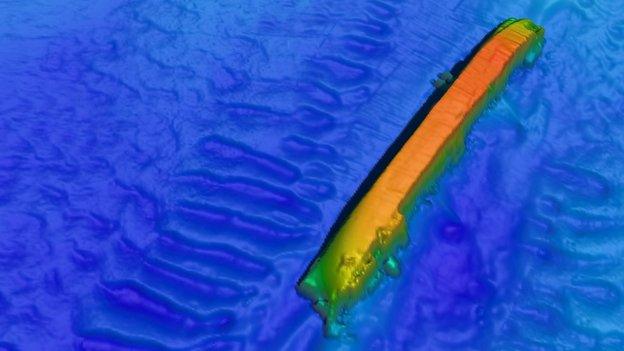WW1: 3D image of tanker sunk by U-boat off Anglesey
- Published

The latest 3D imaging techniques being pioneered by Bangor University have provided the first glimpse of the Derbent in almost 97 years
The latest 3D imaging techniques have provided the first glimpse in nearly a century of an oil tanker sunk by a German U-boat in World War One.
The SS Derbent went down off Amlwch on Anglesey on 30 November 1917.
Built on the decades-old principle of sonar, the Seacams project at Bangor University uses a system which generates 512 sound waves to create a 3D image of the seabed.
The team behind the project hope it could have many other applications.
"The Seacams project allows us to chart the sea floor and survey changes in geography over time," said Dr Mike Roberts, part of the team on the university's Prince Madog research vessel.
"This is one of the many important aspects of science used for finding the optimal site to locate offshore renewable energy installations, and is particularly relevant after the upheaval on the seabed caused by the recent storms.
"But the possible applications are much wider than that. It's a great tool for divers to be able to familiarise themselves with wreck sites before they have to enter dangerous areas in limited visibility, and it's also providing new leads to naval historians and archaeologists."
But while the fundamentals of the system date back almost to the time of the Derbent itself, Dr Roberts explained that his team needed to work on sites that have potential to bring economic value to Wales, hence the interest in wrecks dating back to WW1.
"A traditional sonar system sends out one ping, and by measuring the amount of time it takes to receive an echo signal back, it's possible to measure the distance to an object and create a 2D image," he added.
"The multibeam sonar system used by the Seacams project uses 512 beams fired in a triangle, by moving forward in a vessel you create a 3D image which we know to be accurate to within 20cm.
"We know it's accurate because our findings match with the records which exist for the dimensions of the Derbent."
SS Derbent had only just left Liverpool when it was struck by a torpedo from the U-boat U-96.
Its cargo of oil increased buoyancy, meaning that it took several days to sink, allowing all hands to be saved.
Today it lies on its starboard side in around 45m of water and despite being covered in sand and shellfish, is largely still intact.
- Published3 March 2014
- Published3 March 2014
- Published2 March 2014
- Published1 March 2014
- Published1 March 2014
- Published25 February 2014